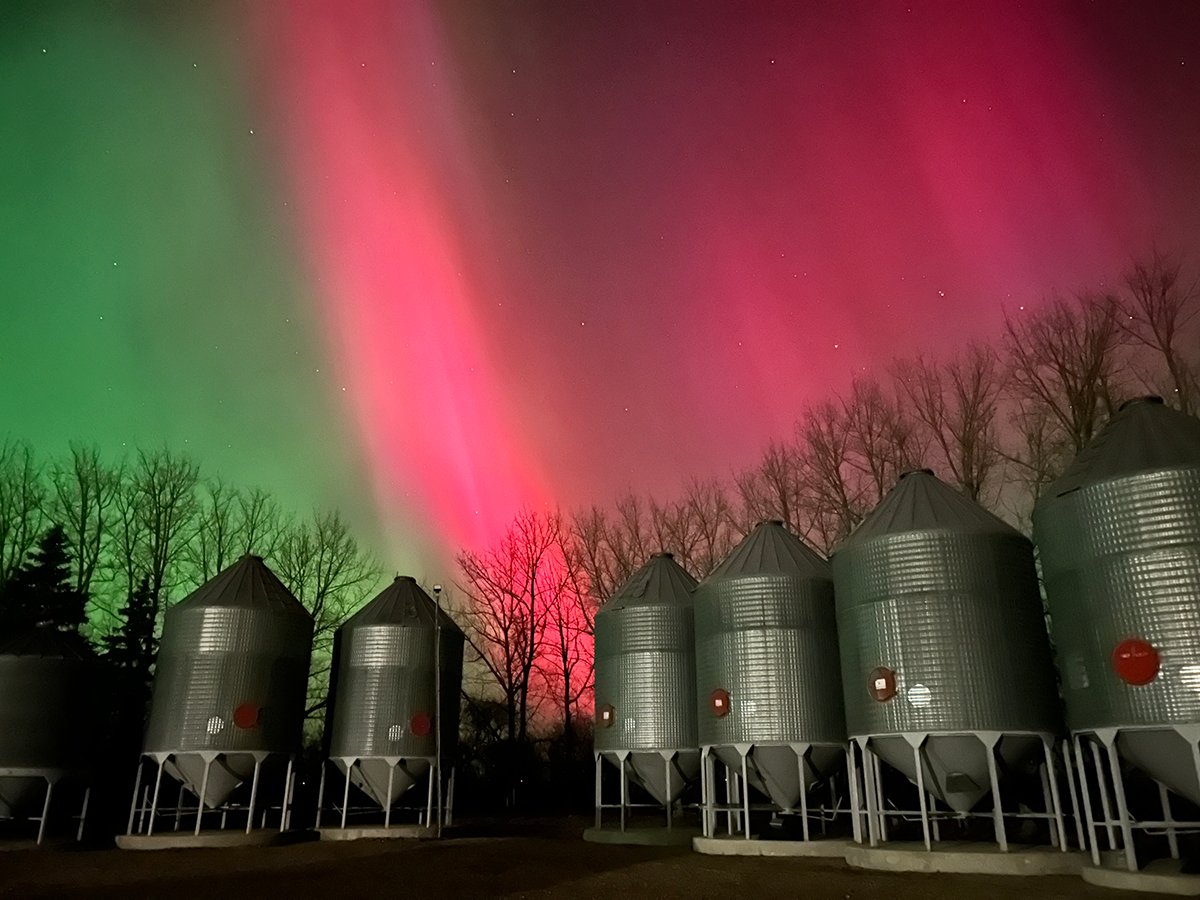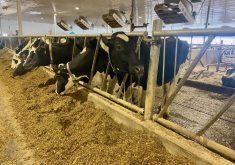I too congratulate The Western Producer on its 80th anniversary. With each decade, family life has changed on the farms and so did the stories and information in the paper.
When everything in the farm kitchen was labour intensive, hired girls were often part of the picture. Just imagine the work involved with cooking on a coal and wood stove, washing clothes on a scrub board in a tub of water carried in from the well, milking the cow and separating the cream in the separator and then washing the separator in water carried in and heated on the stove.
Read Also

Powerful solar storm lights up night time sky
Prairie skywatchers have been on high alert the last few nights as spectacular aurora displays have made the night time…
Often several people, family and hired hands showed up at the kitchen table for full meals, three times a day. There were no store-bought ready-made foods on the pantry shelf nor modern kitchen gadgets available.
If Mother became ill, had a baby or had to be away, she needed help. Then a hired girl became a part of the farm family.
Often the hired help was a young girl from a neighbouring farm. She may not have had experience with all the things asked of her. When my husband was a young boy, he felt sorry for the hired girl they had at their farm. His mother was away in town and a hired girl cooked dinner for the family and hired men. For dessert she had made a lemon pie. When they sliced into it, there were large chunks of lemon. She had put the whole lemon in the pie, in chunks. Everyone was looking at one another as they ate the pie, trying not to giggle. Just then a hired man said “I’m used to having my marmalade for breakfast.”
That put the poor girl in tears.
To this day it is a vivid memory for Bill and likely for the hired girl too.
Unsafe canning
We received a letter from a lady telling how she preserves dill pickles.
This is her letter:
“When I can dill pickles, I put the dill, etc. in the jars, pour hot, salty, vinegar brine on them. I always put a piece of plastic bag on top of the jar, then the lids and seal them tight. Depending on how many jars I have, I put them in a canner or boiler, fill it with hot water from the tap, let them sit overnight. Take out and wipe water off. Put piece of tape on it with the date, store in basement.”
I was concerned about the safety of the methods used and contacted the Food Safety Info Line, 800-892-8333 or jane.carlyle@3web.net.
First, the use of plastic is not safe. According to plastic wrap manufacturers (Saran and Glad) the wrap would not maintain a vacuum seal for long-term storage. Also, plastic wrap or plastic bags would not withstand the heat processing in a water bath canner that is required. It is an inappropriate use of this product. At the temperature for boiling water, the plastic would melt. There are health concerns regarding melted plastic in food.
Second, putting the jars in hot tap water is not adequate. The recommendation for pickles and relishes is to process the product in a boiling water bath canner for the appropriate time to ensure a seal on the snap lid. Processing is also necessary for all pickles and relishes, jams and jellies to destroy the yeasts, moulds and bacteria that may cause the products to spoil and to inactivate enzymes that could affect the colour, flavour and texture of the pickled product.
For all pickled products, proper processing is as follows: Carefully place the filled jars onto a rack in the canner containing hot water. The water should be deep enough to cover the jars by at least one inch (2.5 cm). Cover the canner and bring the water to a boil. Start counting processing time as soon as the water begins to boil. Process for a minimum of 10 minutes or the length of time specified in the recipe, keeping water boiling.
The Food Safety Info Line recommends following a tested recipe that includes processing time. Bernardin is a good source for such recipes.
Bernardin lists these techniques to avoid:
- Blanket steeping – Heating filled jars of food in boiling water and then wrapping the jars in woolen blankets to keep them warm over a period of time is not recommended for any type of food. Food preserved according to this method of food preservation rarely, if ever, reaches temperatures sufficient to destroy micro-organisms. It can be dangerous as the prolonged warm environment may promote bacterial growth inside the jars.
- Grandmother’s recipes – Home canning guidelines were updated in the late 1980s. Home canning recipes or books published before 1988 may contain outdated information that could affect the safety of the end result. Use a reputable canning guide published after 1989.
- Microwave canning – Potentially unsafe devices have been marketed for canning food in a microwave oven. These devices have not been shown to destroy all bacteria present in the food, nor do they heat uniformly. Problems may also occur with food siphoning out of the jars and lid failures. Do not use these devices to can food at home.
- Vacuum sealing devices – Some kitchen appliances can create a vacuum in a mason jar without heat treatment. Since there is no heat treatment to destroy spoilage micro-organisms and botulism bacteria, these organisms can grow under the vacuum seal. Vacuum sealing devices are not safe substitutes for proper heat processing in jars. If you wish to use vacuum sealers with canning jars, use them only for dry ingredients and non-perishable staples.
Making salsa
My tomatoes are ripening on the vine and they are so good. Eating fresh is always the best, but to enjoy them the year round, there are many ways we can preserve their garden flavour.
One way is to make salsa. I hadn’t preserved salsa until a friend asked me for a mild salsa recipe. I now have several jars in the cold room that will be handy for serving with corn chips, as an added ingredient to sour cream or yogurt and served as a veggi dip, or to jazz up ground beef, whether in a meat loaf or in patties. Mexican foods such as fajitas, enchiladas and tacos would not be such the same without salsa.
Your basic chunky tomato salsa
4 medium tomatoes 1 lb. or 500 g
peeled and chopped
1 medium onion, finely chopped
1/2 sweet green pepper, chopped
1-4 jalapeno peppers, halved,
seeded and chopped
3 cloves garlic, minced
1/2 cup tomato sauce 125 mL
1/2 cup red wine vinegar 125 mL
1/2 cup fresh parsley 125 mL
chopped
2 teaspoons granulated 10 mL
sugar
1/2 teaspoon pickling salt 2 mL
1/2 teaspoon ground cumin 2 mL
Combine all ingredients in a large stainless steel or enamel saucepan. Bring to a boil over high heat, reduce heat and boil gently, uncovered, for 25 minutes or until desired consistency, stirring frequently.
Ladle salsa into hot jars to within half inch (one cm) of rim (headspace). Process for 20 minutes for altitudes up to 1,000 feet (305 m). Add five minutes for altitudes 1,001-3,000 feet (306-915 m), add 10 minutes for altitudes 3,001-6,000 feet (916-1,830 m) and add 15 minutes for altitudes 6,001-8,000 feet (1,831 -2,440 m).
Yield approximately three cups (750 mL).
Variations:
Mild salsa: Use one jalapeno pepper.
Medium salsa: Use two or three jalapenos.
Hot salsa: Choose one Scotch bonnet, habanero or Jamaican chile pepper to replace the jalapeno peppers.
Basil or thyme tomato salsa: Replace parsley with fresh basil or thyme.
Sherry vinegar salsa: Replace red wine vinegar with sherry vinegar.
Source: Put A Lid On It! by Ellie Topp & Margaret Howard, Macmillan Canada, 1997.
Ellie Topp & Margaret Howard wrote Put A Lid On It! in 1997 and More Put A Lid On It! in l999. Both books contain up-to-date preserving methods and are canning books I would recommend. The recipes are for small batches, which many of us want. In both books there are many salsa recipes using assorted vegetables as well as fruits. Pickle, jelly, jam, conserve, chutney and other preserving recipes are included.
A salsa mix
Bernardin has a salsa mix for sale in the preserving section of your local store. It contains a seasoning pouch and you add vegetables and apple cider vinegar. Instructions are clearly written for using the mix for tomato salsa, corn salsa or tomato and pepper salsa.
I tried the tomato and pepper recipe with sweet peppers and it was hotter than the plain tomato salsa. Hot peppers can be used if you would like it hot.
This mix can be used for making a small ready-to-serve batch of salsa, omitting the preserving steps.
Alma Copeland is a home economist from Rosetown, Sask., and one of four columnists comprising Team Resources. Send correspondence in care of this newspaper, Box 2500, Saskatoon, Sask., S7K 2C4 or contact them at team@producer.com.














